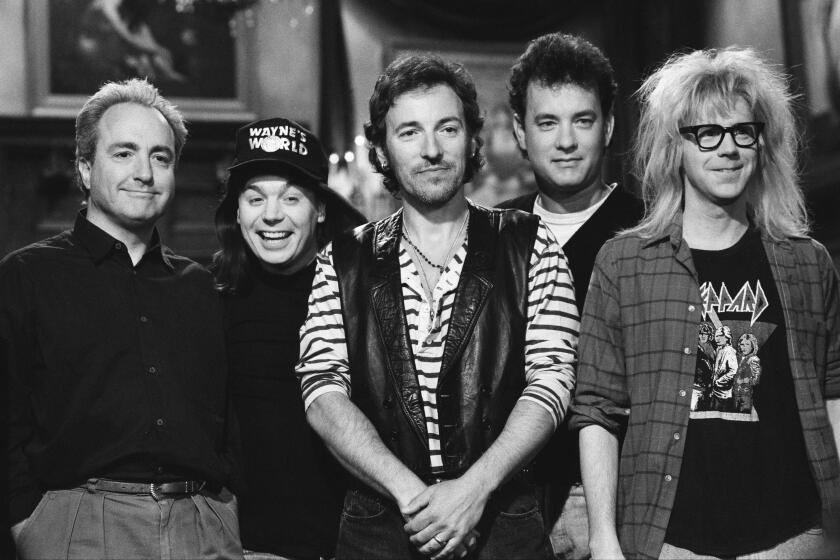Agile del Aguila
- Share via
In the five years that Uruguayan-born-and-bred composer Miguel del Aguila has called Oxnard home, he has made a strong name for himself, locally and beyond. His status in the region was demonstrated by the ovation that reflexively erupted when New West conductor Boris Brott mentioned del Aguila’s name last Friday at the Oxnard Performing Arts Center. Brott was there to guide the orchestra through another del Aguila premiere, his Piano Concerto, Opus 57, with the composer at the piano.
Del Aguila’s music tends to draw consistently from a palette we can by now recognize: Latin sonorities, neo-Romantic melodic flair and a delight in staging subtle musical pranks. And yet, do we know him? However familiar the ingredients, del Aguila manages to stir up fresh things each time out.
His new Piano Concerto is a clever curio, by turns funny, moving and sonically dazzling. Through its three movements, the piece veers back and forth from kitschy sentiment to genuine emotionality, posing an implicit question about what separates the two.
The first movement opens with rumbling percussion, vocal murmuring from the musicians and tolling piano chords, creating a kind of quasi-primal impression. You half expect Yma Sumac to come in over the top with her Hollywood-Andean bird song. The piece also nods to the influence of Esquivel, the recently “rediscovered” master of “space age bachelor-pad music,” who in the late ‘50s and early ‘60s put lounge music on a level approaching high art.
Del Aguila seems to pay his own respects, with his use of Esquivel-like elements in the writing and in the instrumentation. In the slow second movement, del Aguila lays out a melodious theme that threatens to be sticky sweet, but is spiked with just enough dissonances and harmonic deviation to keep sentimentality at bay.
The action turns frenzied in the final movement, as a Latin-pulsed exuberance tinged with impending anarchy ends on a few well-placed “wrong” chords.
In his program notes, del Aguila baits the listener with this mock-disclaimer: “Some will say that the first movement sounds ‘melodramatic’ and ‘old-fashioned,’ the second movement resembles background music for a soap commercial, and the third is simply Miguel’s ‘typical bag of orchestral kitsch and Carmen Miranda-Latin rhythms.’ Many will think it is not serious music.” He said it.
Of course, it is serious, on at least one level. Although the Concerto is a deceptively frilly thing, on the surface pretty, sensuous and silly in almost equal portions, the music floats and rumbles by the ear, raising musical issues and provoking thought.
As expected, the latest del Aguila premiere was an event. He’s a sly radical in formal wear.
Last weekend’s New West program, under the title “Latin Passion,” proved to be an entertaining set from off the beaten path of repertoire, played with the orchestra’s customary flair and focus. Copland’s “Three Latin American Sketches,” orchestrated in 1972, illustrates the composer’s all-American status in the broadest sense--he certainly had an ear open to the “other” Americas.
Joaquin Rodrigo’s ever-popular “Concierto de Aranjuez” was performed nicely by Celino Romero, the youngest of the famed Romero dynasty of classical guitar virtuosos. Lightly amplified to compete with the dynamic forces of the orchestra, the gifted Romero delivered a mostly clean performance. There were a few rough spots and uneasy transitions, but the guitarist had an assured understanding of the piece. This young Romero hasn’t attained the maturity of his elders, but he’s well on his way.
The program closed with a solid reading of Manuel de Falla’s ballet “El Amor Brujo,” the Paris-cum-Andalucian classic. Adding a visual component, Susana Montal displayed her twin skills as singer and dancer.
Romanticism, Rising and Falling: A week earlier, del Aguila was in concert dress in another capacity, presenting his first program in official capacity as music director of the Ojai Camerata. Early indications are that his guidance is making a big difference in levels of quality and commitment to the team.
Under the concert title “Romantics of Three Centuries,” del Aguila led the improved vocal group through music of Faure, Vivaldi and Samuel Barber’s famous lament, best-known in its arrangements as Adagio for Strings.
Barber also adapted the hauntingly simple theme to choral context, as Agnus Dei. It translates well to voice, making it elegiac on a human level, even though definition got a bit smudged in the live, marble-lined space of the Ventura City Hall foyer.
The centerpiece of the concert was an abridged version of the powerful Kurt Weill-Bertolt Brecht opera “Rise and Fall of the City Mahagonny.” Premiered in Germany in 1930 to a riotous reaction, this dark work, about a mythical city succumbing to decadence and inhumanity, foreshadowed the onslaught of Hitler’s Germany.
It’s a masterful and seemingly timeless piece of music, six decades later. The best-known tune is “Oh Moon of Alabama” (“Show me the way to the next whiskey bar . . .”), sung here with world-weary sultriness by Jaye Hersh.
Other soloists, tenor Gabriel Reoyo-Pazos, baritone James Kenney and soprano Deborah Mayhan, rose nicely to the challenge of multiple roles. Keyboardist Karen Corbett provided heroic accompaniment. The chorus, in this case, often seems as much like a satirical taunt squad as an emotional support group, and that’s part of the built-in dark charm of the music.
In the score, modernist touches meet tender semipop tunes, and absurdity is always around the corner, as when it’s noted that, in Mahagonny, “most people had grown weary of this do-what-you-want Mahagonny, and moved to Benares”--the city in India renowned for its funeral rituals. They were, in other words, in the twilight of the living dead. Call it an allegory for our century.
More to Read
The biggest entertainment stories
Get our big stories about Hollywood, film, television, music, arts, culture and more right in your inbox as soon as they publish.
You may occasionally receive promotional content from the Los Angeles Times.










